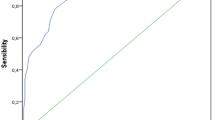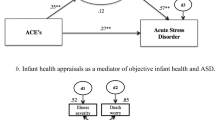Abstract
Objective:
To enhance the clinical utility of the Perinatal Post-Traumatic Stress Disorder (PTSD) Questionnaire (PPQ), the current study sought to refine the measure by changing the item response options from dichotomous choices to a likert scale format.
Study Design:
Using a convergent/divergent validity design and two data sources (traditional survey and World Wide Web), 58 high-risk and 86 low-risk mothers answered four questionnaires.
Results:
Principal components analysis of items on the modified PPQ revealed three components conceptually similar to the diagnostic criterion associated with PTSD. In addition, convergent and divergent validity of the modified measure was supported. The clinical utility of the modified PPQ was established with a strong positive likelihood ratio.
Conclusion:
The modified PPQ is a useful clinical tool for identifying mothers experiencing significant emotional distress during the postnatal period so they may be referred for mental health services.
This is a preview of subscription content, access via your institution
Access options
Subscribe to this journal
Receive 12 print issues and online access
$259.00 per year
only $21.58 per issue
Buy this article
- Purchase on Springer Link
- Instant access to full article PDF
Prices may be subject to local taxes which are calculated during checkout
Similar content being viewed by others
References
Kaplan DM, Mason EA . Maternal reactions to premature birth viewed as an acute emotional disorder. Am J Orthopsychiatry 1959; 30: 539–552.
Benfield DG, Leib SA, Reuter J . Grief response of parents after referral of the critically ill newborn to a regional center. N Engl J Med 1976; 294: 975–978.
Blackburn A, Lowen L . Impact of an infant's premature birth on the grandparents and parents. J Obstet Gynecol Neonatal Nurs 1985; 14: 173–178.
Hynan MT . The emotional reactions of parents to their premature baby. Prenat Pernat Psychol J 1991; 6: 85–95.
Philipp C . The role of recollected anxiety in parental adaptation to low birthweight infants. Child Psychiatry Hum Dev 1983; 13: 239–248.
Silcock A . Crises in parents of prematures: an Austrailian study. Br J Dev Psychol 1984; 2: 257–268.
Jeffcoate JA, Humphrey ME, Lloyd JK . Role perception and response to stress in fathers and mothers following pre-term delivery. Soc Sci Med 1979; 13: 139–145.
Moleman N, van der Hart O, van der Kolk BA . The partus stress reaction: a neglected etiological factor in postpartum psychiatric disorders. J Nerv Men Dis 1992; 180: 271.
Ballard CG, Stanley AK, Brockington IF . Post-traumatic stress disorder (PTSD) after childbirth. Br J Psychiatry 1995; 166: 525–528.
Fones C . Posttraumatic stress disorder occuring after painful childbirth. J Nerv Ment Dis 1996; 184: 195–196.
Ryding EL, Wijma B, Wijma K . Posttraumatic stress reactions after emergency cesarean section. Acta Obstet Gynecol Scand 1997; 76: 856–861.
Light MJ, Sheridan MS . Psychosocial impact of emergency apnea. Am J Dis Child 1987; 141: 668–671.
Affleck G, Tennen H, Rowe J, Higgins P . Mothers' rememberances of newborn intensive care: a predictive study. J Ped Psychol 1990; 15: 67–81.
Hynan MT . The Pain of Premature Parents: A Psychological Guide for Coping. Lanham (MD): University Press of America, 1987.
Ozer EJ, Best SR, Lipsey TL, Weiss DS . Predictors of posttraumatic stress disorder and symptoms in adults: a meta-analysis. Psychol Bull 2003; 129: 52–73.
Creedy DK, Shochet IM, Horsfall J . Childbirth and the development of acute trauma symptoms: incidence and contributing factors. Birth 2000; 27: 104–111.
Czarnocka J, Slade P . Prevalence and predictors of post-traumatic stress symptoms following childbirth. Br J Clin Psychol 2000; 39: 35–51.
Engelhard IM, Van Den Hout MA, Kindt M . Peritraumatic dissociation and posttraumatic stress after pregnancy loss: a prospective study. Behav Res Ther 2003; 41: 67–78.
Olde E, van der Hart O, Kleber R . Posttraumatic stress following childbirth: a review. Clin Psychol Rev 2006; 26: 1–16.
Stainton MC, Harvey S, McNeil D . Understanding Uncertain Motherhood – A Phenomenological Study of Women in High-Risk Perinatal Situations. Faculty of Nursing University of Calgary: Canada, 1995.
DeMier RL, Hynan MT, Harris HB et al. Perinatal stressors as predictors of symptoms of posttraumatic stress in mothers of high-risk infants. J Perinatol 1996; 16: 276–280.
DeMier RL . Predictors of Posttraumatic Stress Disorder Symptoms in Mothers of High-Risk Infants. University Microfilms Int: Ann Arbor (MI), 1994.
Quinnell FA, Hynan MT . Convergent and discriminant validity of the Perinatal PTSD Questionnaire (PPQ). J Trauma Stress 1999; 12: 193–199.
Horowitz MJ, Wilner NR, Alvarez W . Impact of event scale: a measure of subjective distress. Psychosom Med 1979; 41: 209–218.
Hammarberg, M . Penn inventory for posttraumatic stress disorder: psychometric aproperties. Psychol Assess 1992; 4: 67–76.
Callahan JL, Hynan, Michael T . Identifying mothers at risk for postnatal emotional distress: further evidence for the validity of the perinatal posttraumatic stress disorder questionnaire. J Perinatol 2002; 22: 448–454.
Beck AT, Steer RA, Brown GK . Beck Depression Inventory. 2nd ed. The Psychological Corporation: San Antonio, TX, 1996.
Costa Jr PT, McCrae RR . Revised NEO Personality Inventory (NEO PI-R) and NEO Five Factor Inventory (NEO-FFI). Psychological Assessment Resources Inc., Odessa, FL, 1992.
Myers JK, Bean LL . A Decade Later: A Follow-Up of Social Class and Mental Illness. Wiley: New York, 1968.
Briere J, Elliot DM . Clinical utility of the impact of event scale: psychometrics in the general population. Assessment 1998; 5: 171–180.
Blank K, Perry S . Relationship of psychological processes during delirium to outcome. Am J Psychiatry 1984; 141: 843–847.
Cohen L, Roth S . Coping with abortion. J Hum Stress 1984; 10: 140–145.
Perkins DV, Tebes JA . Genuine versus simulated responses on the impact of event scale. Psychol Rep 1984; 54: 575–578.
McCrae RR, Costa Jr PT . Joint factors in self-reports and ratings: neuroticism, extraversion, and openness to experience. Pers Ind Diff 1983; 4: 245–255.
American Psychiatric Association. Diagnostic and Statistical Manual of Mental Disorders. 4th edn. Text revision Author: Washington, DC, 2004.
McNally RJ . Progress and controversy in the study of posttraumatic stress disorder. Ann Rev Psychol 2003; 54: 229–252.
McMillen CJ, North CS, Smith EM . What parts of PTSD are normal: intrusion, avoidance, or arousal? Data from the Northridge California Earthquake. J Trauma Stress 2000; 13: 57–75.
Halbreich U . Postpartum disorders: multiple interacting underlying mechanisms and risk factors. J Affective Dis 2005; 88(1): 1–7.
Hynan MT . The perinatal posttraumatic stress disorder (PTSD) questionnaire (PPQ) In: Zalaquett CP, Wood RJ (eds) Evaluating stress: A book of resources: Volume 2. Scarecrow Press: Lanham, MD, 1998 pp 199–220.
DeMier RL, Hynan MT, Hatfield RF, Varner MW, Harris HB, Maniello RL . A measurement model of perinatal stressors: identifying risk for postnatal emotional distress in mothers of high-risk infants. J Clin Psychol 2000; 56: 89–100.
Fajardo B . Brief intervention with parents in the special care nursery. Neonat Network 1988; 6: 23–30.
Thompson RJ, Goldstein RF, Oehler JM, Gustafson KE, Catlett AT, Brazy JE . Developmental outcome of very low birthweight infants as a function of biological risk and psychosocial risk. Dev Behav Pediatrics 1994; 15: 232–238.
Murray L, Cooper PJ . Postpartum Depression and Child Development. Guilford Press: New York, 1997.
Sameroff AJ, Chandler MJ . Transactional regulation and early intervention In: Meisels SJ and Shonkoff JP (eds) Handbook of Early Childhood Intervention. Cambridge University Press: New York, 1990 pp 119–191.
Meyer EC, Garcia-Coll CT, Lester BM, Boukydis Z, McDonough SM, Oh W . Family based intervention improves maternal psychological well-being and feeding interaction of preterm infants. Pediatrics 1994; 93: 241–246.
Pridham KF, Limbo RK, Schroeder M, Thoyre S, Van Riper M . Guided participation and development of caregiving competencies for families of low birth weight infants. J Adv Nurs 1999; 28: 948–958.
Author information
Authors and Affiliations
Corresponding author
Appendix A
Appendix A
Modified Perinatal Post-traumatic Stress Disorder Questionnaire (Modified PPQ)
Rights and permissions
About this article
Cite this article
Callahan, J., Borja, S. & Hynan, M. Modification of the Perinatal PTSD Questionnaire to enhance clinical utility. J Perinatol 26, 533–539 (2006). https://doi.org/10.1038/sj.jp.7211562
Received:
Revised:
Accepted:
Published:
Issue Date:
DOI: https://doi.org/10.1038/sj.jp.7211562
Keywords
This article is cited by
-
Posttraumatic stress disorder prevalence and childbirth: update meta-analysis after the introduction of the DSM-5 and COVID-19 pandemic
Archives of Women's Mental Health (2024)
-
Maternal mental health and engagement in developmental care activities with preterm infants in the NICU
Journal of Perinatology (2023)
-
Psychometric properties of the European Portuguese version of the modified perinatal PTSD questionnaire (PPQ-II)
Current Psychology (2023)
-
An Association Between Psychological Childbirth Trauma and Hazardous Alcohol Use
International Journal of Mental Health and Addiction (2023)
-
The associations of subjective appraisal of birth pain and provider-patient communication with postpartum-onset PTSD
Archives of Women's Mental Health (2022)



